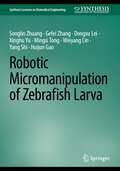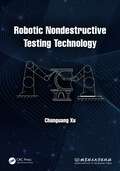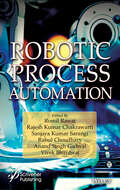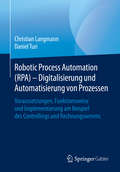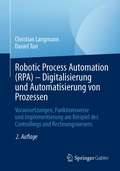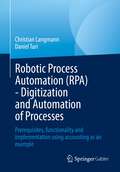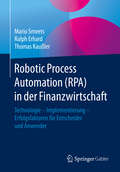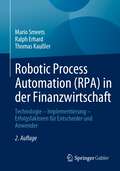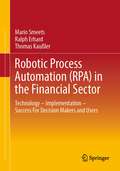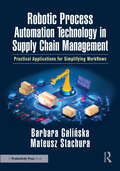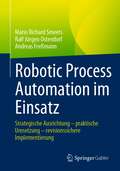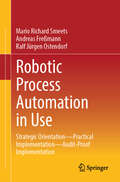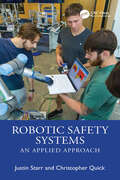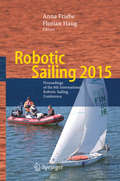- Table View
- List View
Robotic Microassembly
by Michael Gauthier Stephane RegnierDiscover the latest models and methods for robotic microassembly from around the world This book presents and analyzes new and emerging models and methods developed around the world for robotic microassembly, a new and innovative way to produce better microsystems. By exploring everything from the physics of micromanipulation to microassembly to microhandling, it provides the first complete overview and review of this rapidly growing field. Robotic Microassembly is divided into three parts: Part One: Modeling of the Microworld Part Two: Handling Strategies Part Three: Robotic and Microassembly Together, these three parts feature eight chapters contributed by eight different authors. The authors, internationally recognized experts in the field of robotic microassembly, represent research laboratories in Asia, Europe, and North America. As a result, readers get a remarkable perspective on different approaches to robotic microassembly from around the world. Examples provided throughout the chapters help readers better understand how these different approaches work in practice. References at the end of each chapter lead to the primary literature for further investigation of individual topics. Robotic microassembly offers a new, improved way to manufacture high-performance microelectro-mechanical systems (MEMS). Therefore, any professional or student involved in microrobotics, micromechatronics, self-assembly or MEMS will find plenty of novel ideas and methods in this book that set the stage for new approaches to design and build the next generation of MEMS and microproducts.
Robotic Micromanipulation of Zebrafish Larva (Synthesis Lectures on Biomedical Engineering)
by Huijun Gao Yang Shi Songlin Zhuang Gefei Zhang Dongxu Lei Xinghu Yu Mingsi Tong Weiyang LinThis book offers readers a series of robotic methods for manipulating zebrafish larva, one of the most popular model vertebrates widely used in biomedical research and clinical applications. The authors leverage advanced control theories, image processing algorithms, and artificial intelligence to establish a robot-assisted automated or semi-automated zebrafish larva-targeted micromanipulation system for different experimental purposes. The methods presented are generic and can be translated to manipulate other types of biological objects, such as embryos or cells. Coverage includes topics that span the procedures of manipulating zebrafish larva, such as in-plane positioning, three-dimensional orientation, deformation-controllable immobilization, organ-targeted microinjection, whole-organism imaging, and high-throughput trajectory tracking of zebrafish larvae group movement.Robotic Micromanipulation of Zebrafish Larva is written in a simple, clear, and easy-to-read style. It is an ideal reference for academic researchers and biomedical operators. It is also a valuable resource for students learning robotics, control and system theories, image processing, artificial intelligence, and biomedical engineering.
Robotic Musicianship: Embodied Artificial Creativity and Mechatronic Musical Expression (Automation, Collaboration, & E-Services #8)
by Scott Driscoll Gil Weinberg Mason Bretan Guy HoffmanThis book discusses the principles, methodologies, and challenges of robotic musicianship through an in-depth review of the work conducted at the Georgia Tech Center for Music Technology (GTCMT), where the concept was first developed. Robotic musicianship is a relatively new research field that focuses on the design and development of intelligent music-making machines. The motivation behind the field is to develop robots that not only generate music, but also collaborate with humans by listening and responding in an expressive and creative manner. This combination of human and machine creativity has the potential to surprise and inspire us to play, listen, compose, and think about music in new ways. The book provides an in-depth view of the robotic platforms designed at the GTCMT Robotic Musicianship Group, including the improvisational robotic percussionists Haile and Shimon, the personal robotic companion Shimi, and a number of wearable robots, such as the Robotic Drumming Prosthesis, The Third Drumming Arm, and the Skywalker Piano Hand. The book discusses numerous research studies based on these platforms in the context of five main principles: Listen like a Human, Play Like a Machine, Be Social, Watch and Learn, and Wear It.
Robotic Nondestructive Testing Technology
by Chunguang XuThe content of this book includes a variety of nondestructive testing (NDT) methods, with many introductions to testing and application cases. The book proposes new ultrasonic testing technology for complex workpieces. It is hard for traditional NDT technology to realize the automatic detection of complex curved components, especially the automatic high-precision nondestructive detection of curved-surface components with variable curvature, variable thickness and complex contour. Therefore, the robotic NDT technique as a combination of manipulator technique and NDT technique can further improve the efficiency and accuracy of NDT. Robotic NDT Technique combines the physical principle of nondestructive testing with the flexible motion control of spatial attitude of articulated manipulator. With NDT as the constraint, it controls the motion attitude and azimuth angle of a transmitting and receiving transducer. Thus traditional NDT technique has developed from plane to curved surface, from 2D to many dimensions and from artificiality to intelligence, into a unique and systematic interdisciplinary robotic NDT technique.
Robotic Process Automation
by Romil Rawat Rajesh Kumar Chakrawarti Sanjaya Kumar Sarangi Rahul Choudhary Anand Singh Gadwal Vivek BhardwajROBOTIC PROCESS AUTOMATION Presenting the latest technologies and practices in this ever-changing field, this groundbreaking new volume covers the theoretical challenges and practical solutions for using robotics across a variety of industries, encompassing many disciplines, including mathematics, computer science, electrical engineering, information technology, mechatronics, electronics, bioengineering, and command and software engineering. Robotics is the study of creating devices that can take the place of people and mimic their behaviors. Mechanical engineering, electrical engineering, information engineering, mechatronics, electronics, bioengineering, computer engineering, control engineering, software engineering, mathematics, and other subjects are all included in robotics. Robots can be employed in a variety of scenarios and for a variety of objectives, but many are now being used in hazardous areas (such as radioactive material inspection, bomb detection, and deactivation), manufacturing operations, or in conditions where humans are unable to live (e.g. in space, underwater, in high heat, and clean up and containment of hazardous materials and radiation). Walking, lifting, speaking, cognition, and any other human activity are all attempted by robots. Many of today’s robots are influenced by nature, making bio-inspired robotics a growing area. Defusing explosives, seeking survivors in unstable ruins, and investigating mines and shipwrecks are just a few of the activities that robots are designed to undertake. This groundbreaking new volume presents a Robotic Process Automation (RPA) software technique that makes it simple to create, deploy, and manage software robots that mimic human movements while dealing with digital systems and software. Software robots can interpret what’s on a screen, type the correct keystrokes, traverse systems, locate and extract data, and do a wide variety of predetermined operations, much like people. Software robots can do it quicker and more reliably than humans, without having to stand up and stretch or take a coffee break.
Robotic Process Automation (RPA) - Digitalisierung und Automatisierung von Prozessen: Voraussetzungen, Funktionsweise und Implementierung am Beispiel des Controllings und Rechnungswesens
by Christian Langmann Daniel TuriDas vorliegende Buch gibt einen praxisorientierten Überblick über die notwendigen Voraussetzungen, die Funktionsweise sowie die einzelnen Schritte für die erfolgreiche Einführung von Robotic Process Automation (RPA). Neben theoretischen Grundlagen verdeutlichen Umsetzungsbeispiele aus der Praxis aus Controlling und Rechnungswesen das enorme Potenzial dieser Technologie.
Robotic Process Automation (RPA) - Digitalisierung und Automatisierung von Prozessen: Voraussetzungen, Funktionsweise und Implementierung am Beispiel des Controllings und Rechnungswesens
by Christian Langmann Daniel TuriDas vorliegende Buch gibt einen praxisorientierten Überblick über die notwendigen Voraussetzungen, die Funktionsweise sowie die einzelnen Schritte für die erfolgreiche Einführung von Robotic Process Automation (RPA). Neben theoretischen Grundlagen verdeutlichen Umsetzungsbeispiele aus der Praxis aus Controlling und Rechnungswesen das enorme Potenzial dieser Technologie. Die 2. Auflage ist unter anderem um den Einsatz von Intelligent Process Automation (IPA) erweitert, z.B. in Form von Spracherkennung mittels Natural Language Processing (NLP) oder Machine Learning.
Robotic Process Automation (RPA) - Digitization and Automation of Processes: Prerequisites, functionality and implementation using accounting as an example
by Christian Langmann Daniel TuriThis book provides a practice-oriented overview of the necessary prerequisites, the mode of operation, and the individual steps for the successful introduction of Robotic Process Automation (RPA). In addition to theoretical basics, practical examples from controlling and accounting illustrate the enormous potential of this technology....
Robotic Process Automation (RPA) in der Finanzwirtschaft: Technologie – Implementierung – Erfolgsfaktoren für Entscheider und Anwender
by Mario Smeets Ralph Erhard Thomas KaußlerDieses Buch bringt Ihnen die Robotic Process Automation in der Finanzwirtschaft näher In der Finanzbranche ist das Thema Prozessautomatisierung seit Jahren nicht mehr wegzudenken. Doch wie setzt man solche Veränderungen im Rahmen des Changemanagements erfolgreich und effizient um? Das Buch „Robotic Process Automation in der Finanzwirtschaft“ zeigt es Ihnen. Im Fokus steht der recht junge RPA-Ansatz aus der Intelligent Automation. Dabei imitieren Roboter das menschliche Handeln. Die Eingabe von Befehlen erfolgt direkt über die Oberfläche. So gehören tiefgreifende Softwareveränderungen der Vergangenheit an. Im Zuge dessen klärt dieses Buch u. a. folgende Fragen bezüglich der Robotic Process Automation in der Finanzwirtschaft: • Was ist RPA überhaupt? • Welche Vorteile bringt diese Technologie mit sich? • Welche Erfolgsfaktoren tragen zu einer optimalen RPA-Implementierung bei? • Wie sieht ein mögliches RPA-Kompetenzcenter aus? • Welche Anwendungsbereiche für RPA gibt es? Eine Leseempfehlung für ein breites Zielpublikum Daneben beschäftigen sich die Autoren nicht nur mit dem Ist-Zustand der Robotic Process Automation. Zudem erhalten Sie einen Ausblick auf die zukünftige Entwicklung dieser Software-Lösung. Durch den hohen Praxisbezug ist das Buch speziell für folgende Zielgruppen eine lesenswerte Empfehlung: • Verantwortliche für die Implementierung von Prozessen oder Technologien im IT-Bereich • RPA-Anwender und Personen, die sich dafür interessieren • Erfahrene Experten und Praktiker, die branchenübergreifend mit RPA vertraut sind
Robotic Process Automation (RPA) in der Finanzwirtschaft: Technologie – Implementierung – Erfolgsfaktoren für Entscheider und Anwender
by Mario Smeets Ralph Erhard Thomas KaußlerDieses Buch bringt Ihnen die Robotic Process Automation in der Finanzwirtschaft näher In der Finanzbranche ist das Thema Prozessautomatisierung seit Jahren nicht mehr wegzudenken. Doch wie setzt man solche Veränderungen im Rahmen des Changemanagements erfolgreich und effizient um? Das Buch „Robotic Process Automation in der Finanzwirtschaft“ zeigt es Ihnen. Im Fokus steht der recht junge RPA-Ansatz aus der Intelligent Automation. Dabei imitieren Roboter das menschliche Handeln. Die Eingabe von Befehlen erfolgt direkt über die Oberfläche. So gehören tiefgreifende Softwareveränderungen der Vergangenheit an. Im Zuge dessen klärt dieses Buch u. a. folgende Fragen bezüglich der Robotic Process Automation in der Finanzwirtschaft: • Was ist RPA überhaupt? • Welche Vorteile bringt diese Technologie mit sich? • Welche Erfolgsfaktoren tragen zu einer optimalen RPA-Implementierung bei? • Wie sieht ein mögliches RPA-Kompetenzcenter aus? • Welche Anwendungsbereiche für RPA gibt es? Eine Leseempfehlung für ein breites Zielpublikum Daneben beschäftigen sich die Autoren nicht nur mit dem Ist-Zustand der Robotic Process Automation. Zudem erhalten Sie einen Ausblick auf die zukünftige Entwicklung dieser Software-Lösung. Durch den hohen Praxisbezug ist das Buch speziell für folgende Zielgruppen eine lesenswerte Empfehlung: • Verantwortliche für die Implementierung von Prozessen oder Technologien im IT-Bereich • RPA-Anwender und Personen, die sich dafür interessieren • Erfahrene Experten und Praktiker, die branchenübergreifend mit RPA vertraut sind
Robotic Process Automation (RPA) in the Financial Sector: Technology - Implementation - Success For Decision Makers and Users
by Mario Smeets Ralph Erhard Thomas KaußlerDieses Buch bringt Ihnen die Robotic Process Automation in der Finanzwirtschaft näher In der Finanzbranche ist das Thema Prozessautomatisierung seit Jahren nicht mehr wegzudenken. Doch wie setzt man solche Veränderungen im Rahmen des Changemanagements erfolgreich und effizient um? Das Buch „Robotic Process Automation in der Finanzwirtschaft“ zeigt es Ihnen. Im Fokus steht der recht junge RPA-Ansatz aus der Intelligent Automation. Dabei imitieren Roboter das menschliche Handeln. Die Eingabe von Befehlen erfolgt direkt über die Oberfläche. So gehören tiefgreifende Softwareveränderungen der Vergangenheit an. Im Zuge dessen klärt dieses Buch u. a. folgende Fragen bezüglich der Robotic Process Automation in der Finanzwirtschaft: • Was ist RPA überhaupt? • Welche Vorteile bringt diese Technologie mit sich? • Welche Erfolgsfaktoren tragen zu einer optimalen RPA-Implementierung bei? • Wie sieht ein mögliches RPA-Kompetenzcenter aus? • Welche Anwendungsbereiche für RPA gibt es? Eine Leseempfehlung für ein breites Zielpublikum Daneben beschäftigen sich die Autoren nicht nur mit dem Ist-Zustand der Robotic Process Automation. Zudem erhalten Sie einen Ausblick auf die zukünftige Entwicklung dieser Software-Lösung. Durch den hohen Praxisbezug ist das Buch speziell für folgende Zielgruppen eine lesenswerte Empfehlung: • Verantwortliche für die Implementierung von Prozessen oder Technologien im IT-Bereich • RPA-Anwender und Personen, die sich dafür interessieren • Erfahrene Experten und Praktiker, die branchenübergreifend mit RPA vertraut sind
Robotic Process Automation Technology in Supply Chain Management: Practical Applications for Simplifying Workflows
by Barbara Galińska Mateusz StachuraThis book analyses and presents the application of Robotic Process Automation technology (RPA) in supply chain management. It chronologically describes supply chain issues (definition and features, schema, management aspects, problems) and trends of Industry 4.0 solutions in supply chain management. It then describes RPA technology (definition and features, examples of use, and advantages and disadvantages). Essentially, readers gain the necessary knowledge of the most important features of Robotic Process Automation technology in supply chain management. The elements analysed focus on the supply chain and its functioning, the use of modern Industry 4.0 solutions in supply chain management, RPA technology, and its advantages or disadvantages. Noteworthy are the last two chapters, in which a conceptual model for the use of RPA in a company is developed, based on the results of the research conducted (case study). It demonstrates that with basic office tools, business process automation can be created, enabling the implementation of Industry 4.0 solutions.
Robotic Process Automation im Einsatz: Strategische Ausrichtung – praktische Umsetzung – revisionssichere Implementierung
by Mario Richard Smeets Ralf Jürgen Ostendorf Andreas FreßmannSeit einigen Jahren beschäftigt die Automatisierung beliebiger Prozesse und Prozessschritte mit der RPA-Technologie die Finanzwirtschaft. Mittlerweile aus dem Alltag vieler sachbearbeitenden Bereiche nicht mehr wegzudenken. Wie funktioniert die Technologie, wer trägt die Verantwortung und was sind die Risiken eines Einsatzes in der eigenen Bank? Das Buch beantwortet diese und viele verwandte Fragen zu RPA, die sich insbesondere interne und externe Prüfer, aber auch Entscheider stellen. Neben einer Einführung in die Technologie und der Einordnung in einen weitgefassten, strategischen Kontext, wird insbesondere die Thematik der richtigen "Prüfung und Beurteilung" der Technologie diskutiert.
Robotic Process Automation in Use: Strategic Orientation - Practical Implementation - Audit-Proof Implementation
by Mario Richard Smeets Ralf Jürgen Ostendorf Andreas FreßmannFor some years now, the automation of any number of processes and process steps using RPA technology has been keeping the financial sector busy. It has now become an integral part of everyday life in many business areas. How does the technology work, who is responsible and what are the risks of using it in your own bank? This book answers these and many related questions about RPA, which are asked in particular by internal and external auditors, but also by decision-makers. In addition to an introduction to the technology and its classification in a broad, strategic context, the topic of the correct "auditing and assessment" of the technology is discussed.
Robotic Safety Systems: An Applied Approach
by Justin Starr Christopher QuickThis book reboots the conversation about all technologies relating to robot safety. It covers key features of industry standards, relevant government regulations, hardware devices, physical safeguards, and vendor-specific software implementations, including FANUC's Dual-Check Safety, ABB's SafeMove and more.Robotic Safety Systems: An Applied Approach discusses some of the unique concerns associated with remote I/O and systems designed to be controlled over wide-area networks, including the internet. It includes annotated example safety configurations and programs that can be customized and loaded and deployed on existing robots, giving the reader tools to immediately apply the lessons learned in this text. The text also provides best practices for using cutting-edge systems – such as cobots and mobile robotic arms (with some autonomy) – systems that have advanced faster than the regulatory frameworks. Included are real world examples from FANUC, ABB, Universal Robots, and Kuka – the most popular brands on the market. Finally, as an appendix to this text, a case study demonstrating proper use of A3/RIA standards is included. This will allow readers to make an informed decision prior to purchasing these expensive references.This book is intended for post-secondary classes at universities with specializations in robotics or robotic engineering. It will also be useful for robot systems integrators – design engineers, consultants, integration experts, robot programmers.
Robotic Sailing 2015
by Anna Friebe Florian HaugThis book presents the cutting edge developments within a broad field related to robotic sailing. The contributions were presented during the 8th International Robotic Sailing Conference, which has taken place as a part of the 2015 World Robotic Sailing Championships in Mariehamn, Åland (Finland), August 31st - September 4th 2015. Since more than a decade, a series of competitions such as the World Robotic Sailing Championship have stimulated a variety of groups to work on research and development around autonomous sailing robots, which involves boat designers, naval architects, electrical engineers and computer scientists. While many of the challenges in building a truly autonomous sailboat are still unsolved, the books presents the state of the art of research and development within platform optimization, route and stability planning, collision avoidance, power management and boat control.
Robotic Sailing 2016
by José C. Alves Nuno A. CruzThis book contains selected papers that address a variety of topics related to the design, development and operation of unmanned and fully autonomous sailing boats. These papers were presented in the 9th International Robotic Sailing Conference, in association with the 9th World Robotic Sailing Championship that took place in Viana do Castelo, Portugal from the 5th to 10th of September 2016. The book is divided in three parts, each focusing on key aspects of robotic sailing. The first part addresses the design, construction and validation of autonomous sailboat platforms, including their rigs, appendages and control mechanisms. The second part is devoted to the development of sensors and algorithms to enhance the performance of robotic sailing boats, in terms of their speed, course control and manoeuvring ability. Finally, the papers in the last part are dedicated to the improvement of behaviours required for the accomplishment of complex autonomous missions. Robotic sailing is a relatively new multidisciplinary area of research, with a recognized great potential for persistent ocean observation. Using the wind for boat propulsion is something mankind has been doing for centuries. Automating and optimizing the sailing process in the harsh marine environment is an ever present challenge which is now promising to bear fruit.
Robotic Sailing 2017
by Kjell Ivar ØvergårdRobotic Sailing 2017. This book contains the peer-reviewed papers presented at the 10th International Robotic Sailing Conference which was organized in conjunction with the 10th World Robotic Sailing Championship held in Horten, Norway the 4th-9th of September 2017. The seven papers cover topics of interest for autonomous robotic sailing which represents some of the most challenging research and development areas. The book is divided into two parts. The first part contains papers which focus on the design of sails and software for the assessment and predication of sailboat performance as well as software platforms and middleware for sailboat competition and research. The second part includes algorithms and strategies for navigation and collision avoidance on local, mid- and long range. The differences in approach in the included papers show that robotic sailing is still an emerging cross-disciplinary science. The multitude of suggestions to the specific problems of prediction and simulation of sailboats as well as the challenges of route planning, anti-grounding and collision avoidance are good indicators of science in its infancy. Hence, we may expect the future to hold great advances for robotic sailing.
Robotic Tactile Sensing
by Maurizio Valle Ravinder S. DahiyaFuture robots are expected to work closely and interact safely with real-world objects and humans alike. Sense of touch is important in this context, as it helps estimate properties such as shape, texture, hardness, material type and many more; provides action related information, such as slip detection; and helps carrying out actions such as rolling an object between fingers without dropping it. This book presents an in-depth description of the solutions available for gathering tactile data, obtaining aforementioned tactile information from the data and effectively using the same in various robotic tasks. The efforts during last four decades or so have yielded a wide spectrum of tactile sensing technologies and engineered solutions for both intrinsic and extrinsic touch sensors. Nowadays, new materials and structures are being explored for obtaining robotic skin with physical features like bendable, conformable, and stretchable. Such features are important for covering various body parts of robots or 3D surfaces. Nonetheless, there exist many more hardware, software and application related issues that must be considered to make tactile sensing an effective component of future robotic platforms. This book presents an in-depth analysis of various system related issues and presents the trade-offs one may face while developing an effective tactile sensing system. For this purpose, human touch sensing has also been explored. The design hints coming out of the investigations into human sense of touch can be useful in improving the effectiveness of tactile sensory modality in robotics and other machines. Better integration of tactile sensors on a robot's body is prerequisite for the effective utilization of tactile data. The concept of semiconductor devices based sensors is an interesting one, as it allows compact and fast tactile sensing systems with capabilities such as human-like spatio-temporal resolution. This book presents a comprehensive description of semiconductor devices based tactile sensing. In particular, novel Piezo Oxide Semiconductor Field Effect Transistor (POSFET) based approach for high resolution tactile sensing has been discussed in detail. Finally, the extension of semiconductors devices based sensors concept to large and flexile areas has been discussed for obtaining robotic or electronic skin. With its multidisciplinary scope, this book is suitable for graduate students and researchers coming from diverse areas such robotics (bio-robots, humanoids, rehabilitation etc.), applied materials, humans touch sensing, electronics, microsystems, and instrumentation. To better explain the concepts the text is supported by large number of figures.
Robotic Technologies in Biomedical and Healthcare Engineering (Biomedical and Robotics Healthcare)
by Deepak Gupta Ashish Khanna Moolchand Sharma Vikas ChaudharyNew prospects for biomedical and healthcare engineering are being created by the rapid development of Robotic and Artificial Intelligence techniques. Innovative technologies such as Artificial Intelligence, Deep Learning, Robotics, and IoT are currently under huge influence in today’s modern world. For instance, a micro-nano robot allows us to study the fundamental problems at a cellular scale owing to its precise positioning and manipulation ability; the medical robot paves a new way for the low-invasive and high-efficient clinical operation, and rehabilitation robotics is able to improve the rehabilitative efficacy of patients. This book aims at exhibiting the latest research achievements, findings, and ideas in the field of robotics in biomedical and healthcare engineering, primarily focusing on the walking assistive robot, telerobotic surgery, upper/lower limb rehabilitation, and radiosurgery. As a result, a wide range of robots are being developed to serve a variety of roles within the medical environment. Robots specializing in human treatment include surgical robots and rehabilitation robots. The field of assistive and therapeutic robotic devices is also expanding rapidly. These include robots that help patients rehabilitate from severe conditions like strokes, empathic robots that assist in the care of older or physically/mentally challenged individuals, and industrial robots that take on a variety of routine tasks, such as sterilizing rooms and delivering medical supplies and equipment, including medications. The objectives of the book are in terms of advancing the state-of-the-art of robotic techniques and addressing the challenging problems in biomedical and healthcare engineering. This book Lays a good foundation for the core concepts and principles of robotics in biomedical and healthcare engineering, walking the reader through the fundamental ideas with expert ease. Progresses on the topics in a step-by-step manner and reinforces theory with a full-fledged pedagogy designed to enhance students’ understanding and offer them a practical insight into the applications of it. Features chapters that introduce and cover novel ideas in healthcare engineering like Applications of Robots in Surgery, Microrobots and Nanorobots in Healthcare Practices, Intelligent Walker for Posture Monitoring, AI-Powered Robots in Biomedical and Hybrid Intelligent Systems for Medical Diagnosis, and so on. Deepak Gupta is an Assistant Professor at the Maharaja Agrasen Institute of Technology, GGSIPU, Delhi, India. Moolchand Sharma is an Assistant Professor at the Maharaja Agrasen Institute of Technology, GGSIPU, Delhi, India. Vikas Chaudhary is a Professor at the JIMS Engineering Management Technical Campus, GGSIPU, Greater Noida, India. Ashish Khanna currently works at the Maharaja Agrasen Institute of Technology, GGSIPU, Delhi, India.
Robotic Vehicles: Systems and Technology
by Tian Seng NgThis book introduces the technological innovations of robotic vehicles. It presents the concepts required for self-driving cars on the road. Besides, readers can gain invaluable knowledge in the construction, programming, and control of the six-legged robot. The book also presents the controllers and aerodynamics of several different types of rotorcrafts. It includes the simulation and flight of the various kinds of rotor-propelled air vehicles under each of their different aerodynamics environment. The book is suitable for academia, educators, students, and researchers who are interested in autonomous vehicles, robotics, and rotor-propelled vehicles.
Robotic Vision Guidance Theory and Technology
by Xingsheng Liu Anhu Li Zhaojun DengThis book focuses on the basic theories and key technologies for robotic vision. The book features an in-depth demonstration of system parameter calibration, three-dimensional vision measurement, object pose estimation, tracking control strategies, and multi-sensor fusion methods, accompanied by robotic guidance solutions in various applications. The contributed work can help promote the development and application of robotic guidance for autonomous navigation, grasping and manipulation tasks. Researchers and engineers in the field of robotic perception, visual measurement and visual tracking can benefit from the book. The potential users include undergraduates and postgraduates majoring in intelligent manufacturing and artificial intelligence. The basis of English translation of this book, originally in Chinese, was facilitated by artificial intelligence. The content was later revised by the author for accuracy.
Robotic Welding, Intelligence and Automation
by Tzyh-Jong Tarn Shan-Ben Chen Xiao-Qi ChenThe primary aim of this volume is to provide researchers and engineers from both academic and industry with up-to-date coverage of new results in the field of robotic welding, intelligent systems and automation. The book is mainly based on papers selected from the 2014 International Conference on Robotic Welding, Intelligence and Automation (RWIA'2014), held Oct. 25-27, 2014, at Shanghai, China. The articles show that the intelligentized welding manufacturing (IWM) is becoming an inevitable trend with the intelligentized robotic welding as the key technology. The volume is divided into four logical parts: Intelligent Techniques for Robotic Welding, Sensing of Arc Welding Processing, Modeling and Intelligent Control of Welding Processing, as well as Intelligent Control and its Applications in Engineering.
Robotica: Speech Rights and Artificial Intelligence
by Ronald K. L. Collins David M. SkoverIn every era of communications technology - whether print, radio, television, or Internet - some form of government censorship follows to regulate the medium and its messages. <P><P>Today we are seeing the phenomenon of 'machine speech' enhanced by the development of sophisticated artificial intelligence. <P>Ronald K. L. Collins and David M. Skover argue that the First Amendment must provide defenses and justifications for covering and protecting robotic expression. It is irrelevant that a robot is not human and cannot have intentions; what matters is that a human experiences robotic speech as meaningful. This is the constitutional recognition of 'intentionless free speech' at the interface of the robot and receiver. Robotica is the first book to develop the legal arguments for these purposes. Aimed at law and communication scholars, lawyers, and free speech activists, this work explores important new problems and solutions at the interface of law and technology.<P> Offers a new theory of First Amendment speech rights that covers robotic expression.<P> Describes the evolution of communications technologies and government efforts to censor them.<P> Proposes a First Amendment theory of utility to justify protection for robotic expression.
Robotics
by Fernando S. Osório Denis Fernando Wolf Kalinka Castelo Branco Valdir Grassi Marcelo Becker Roseli A. Francelin RomeroThis book constitutes the refereed proceedings of the Joint Conference on Robotics, LARS, SBR, Robocontrol 2014, held in São Carlos, Brazil, in October 2014. The 8 revised full papers presented were carefully reviewed and selected from 76 submissions. The selected papers present a complete and solid reference of the state-of-the-art of intelligent robotics and automation research, covering the following areas: autonomous mobile robots, tele-operated and telepresence robots, human-robot interaction, trajectory control for mobile robots, autonomous vehicles, service-oriented robotic systems, semantic mapping, environment mapping, visual odometry, applications of RGB-D sensors, humanoid and biped robots, Robocup soccer robots, robot control, path planning, multiple vehicles and teams of robots.

